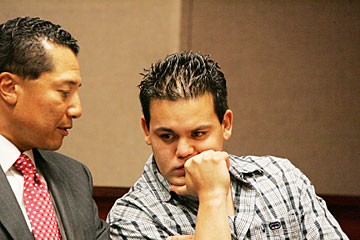
|
My Turn
Jim Borg
|
Nagging questions remain in Rodrigues case
Authorities say they will take another look at fingerprint evidence
IN JUNE 2000, Dianne Sugihara, a librarian at McKinley High School, arranged for the alarm to be checked at her house in Manoa, which had recently been burglarized.
Arthur Lee, owner of Hawaii Alarm Systems, came over to handle the job. With him was an employee, Shaun C. Rodrigues, then 20, a graduate of Kailua High School and a Hawaii National Guard soldier. Together, Lee and Rodrigues worked on the inspection, and then Rodrigues returned by himself on June 27 to set up a second alarm speaker.
Sugihara by then was calling Rodrigues by his first name and served him a soft drink while he worked.
Just over a week later, around 9 a.m. on July 8, 2000, Sugihara was home alone and taking a shower upstairs when she heard a noise outside the bathroom. She was expecting her daughter, Dawn Sugihara, then a law student, because the two had planned to go shopping.

STAR-BULLETIN
Shaun Rodrigues, right, talks with an attorney before his sentencing in a Manoa robbery. He maintains his innocence.
|
|
When she looked outside the bathroom, she saw a man aiming a small silver handgun at her.
Dianne did not have her contact lenses in and later told police she did not get a good look at the intruder.
She then realized that Dawn also was in the bedroom. The gunman ordered both women to lie face-down on the floor. He allowed Dianne to put a towel around herself first, assuring her that he was not a rapist.
Once they were prone, the intruder tied the women's hands with cord and tossed a pair of shorts over Dianne's face.
Dawn Sugihara later told police she got a two-to-five-second look at the man, who wore no mask, before she went down on the floor, from where she noticed he was wearing baggy blue denim jeans and yellow work boots and that he placed items into a black backpack.
The women heard the intruder rummage around the house for about 20 minutes and then, emboldened by silence, untied themselves and dialed 911.
Detective Robert Cravalho was struck by the fact that this was the second Manoa area burglary in a week in which a burglar alarm had apparently been circumvented. Both alarm systems had been upgraded by the same worker from Hawaii Alarm, Shaun Rodrigues.
So when Dianne and Dawn Sugihara came down to the police station on July 10 to give a description of the suspect to an artist, they were instead shown a set of six photographs. One of the six was Rodrigues' driver's license photo.
Separately, both women picked Rodrigues' photo, telling detectives that this was the man who had robbed them two days earlier.
Curiously, however, Dianne Sugihara did not recognize the photo as belonging to the man who installed her burglar alarm.
When Cravalho pointed out the connection, she looked puzzled. When the realization hit her, she began to "shake uncontrollably," according to court documents.
On strength of the Sugiharas' identification, in March 2002 Rodrigues was convicted in a nonjury trial of five felonies, including first-degree robbery. He was sentenced to 20 years in prison and, after the conviction was upheld by the Hawaii Supreme Court on Dec. 7, began serving time last week.
Rodrigues continues to insist he is innocent, claiming he was home in Kailua at the time of the robbery.
In finding him guilty, Circuit Court Judge Virginia Crandall chose to believe the Sugiharas' identification over the testimony of Rodrigues' mother, stepfather, brother and other family members that he was asleep in plain view on the family room futon during the relevant hours.
With his state appeals exhausted, Rodrigues' attorney, William Harrison, plans to turn to the federal courts for relief in a case that continues to present nagging questions.
» If Rodrigues is the culprit, why did he not wear a mask when he went to burglarize a home where he was known? The intruder's possession of a gun suggests he was prepared to run into someone.
» From a ransacked black Chinese jewelry box in Dawn Sugihara's room, a police evidence specialist lifted a clear fingerprint. It does not match Rodrigues. Whose is it?
No other physical evidence was found at the scene.
A search of Rodrigues' house turned up nothing to link him to the crime: no stolen goods, no denim jeans, no work boots. Police did find a big pellet gun that the Sugiharas later said was not the one used in the robbery.
All the while, Rodrigues' family has insisted he was home. His mother, Antoinette Kurihara, and her husband, Todd Kurihara, went out to breakfast at some point in the morning. The exact time became an issue at trial, but they say Shaun was sleeping in the family room when they left and when they returned.
They said he was on the futon because his sister, who has asthma, was using Shaun's room, which is air-conditioned.
Shaun's brother, Royce, told police he was there in the room with Shaun the entire time.
When their grandmother, Esther Specht, called from California, Royce informed her that Shaun was asleep. Phone records show that call came in at 8:56 a.m.
The case is all the more frustrating to Harrison because he has identified another possible suspect.
After the trial was over, on a tip from a Hawaii inmate at the Diamondback Correctional Facility in Oklahoma, Harrison was given the name of man convicted of a home invasion robbery of an elderly woman in Kailua.
That man was working on a construction job at Manoa Elementary School, just blocks from the Sugihara home, in July 2000. When Harrison contacted the company, Suncrete, he confirmed that the individual in question did not show up for work on the day of the robbery.
Meanwhile, Harrison ran newspaper ads earlier last month appealing to the public for any more leads. He says he got one promising response, but no follow-up from the caller.
Some of the residual questions in the Manoa robbery case might never be answered. But in researching the case this week, the Star-Bulletin learned that the fingerprint recovered from the jewelry box has never been compared to the prints of the second potential suspect.
That seems like a loose end that could easily be tied up.
And on Friday, after an e-mail request, the Honolulu Prosecutor's Office agreed to make the comparison.
The Sugiharas have been shown photos of the second potential suspect and have said he is not the intruder.
But law enforcement officials have long known that eyewitness identification is far from infallible.
"Even the most honest and objective people can make mistakes in recalling and interpreting a witnessed event," the U.S. Justice Department advised in a 1999 position paper. "It is the nature of human memory."
Jim Borg, a veteran reporter and magazine editor, is a Star-Bulletin copy editor.
My Turn is a periodic column written by Star-Bulletin staff members expressing their personal views.

